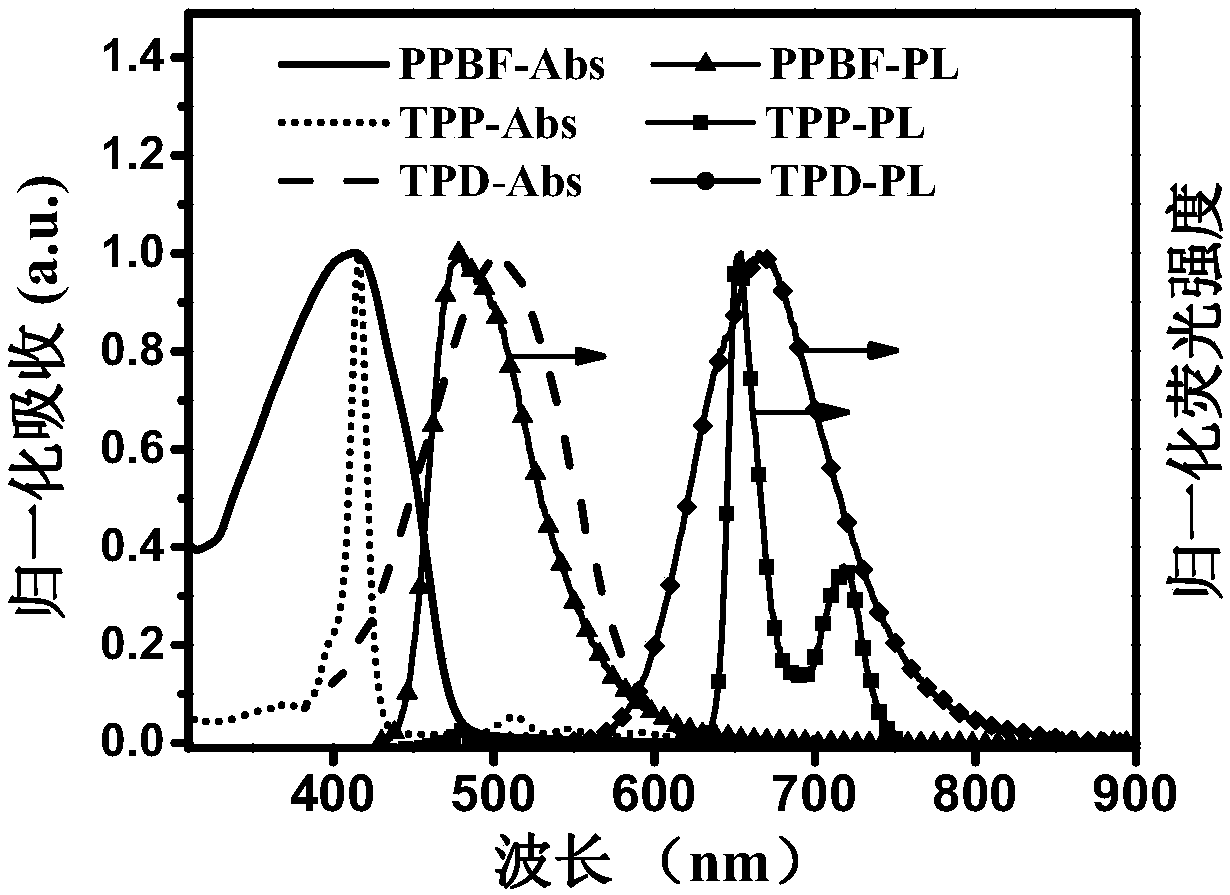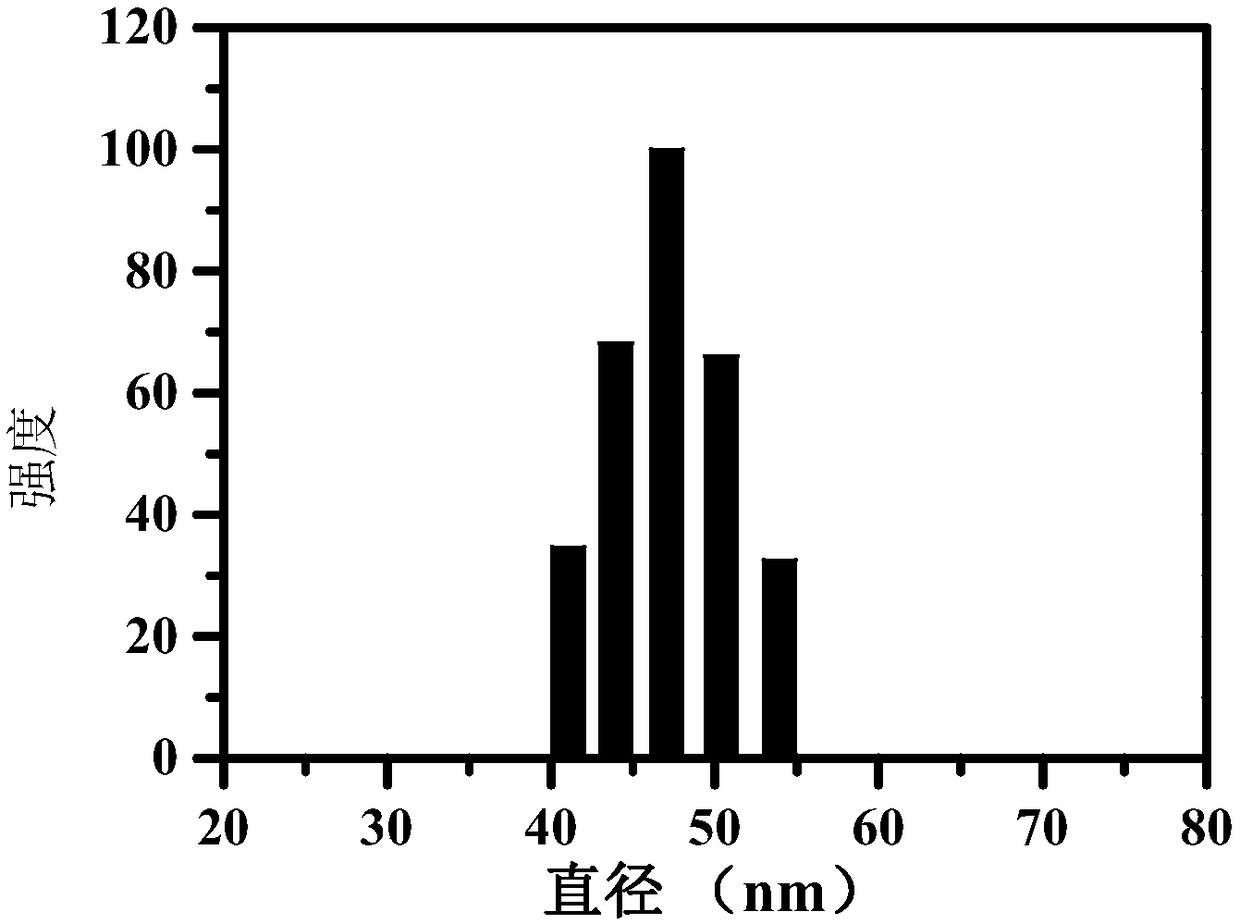Nano photosensitive material containing conjugated polymer and having two-photon imaging function and photodynamic curative efficacy as well as preparation and application
A conjugated polymer, two-photon imaging technology, applied in the field of anti-tumor drugs, can solve the problems of low fluorescence quantum efficiency of photosensitizers, unable to use synchronous biological imaging, etc., and achieve high therapeutic efficiency, efficient two-photon imaging function, strong dual-photon imaging, etc. Effects of Photon-Excited Fluorescence Emission Properties
- Summary
- Abstract
- Description
- Claims
- Application Information
AI Technical Summary
Problems solved by technology
Method used
Image
Examples
Embodiment 1
[0061] A method for preparing a conjugated polymer nano-photosensitive material with two-photon imaging and photodynamic therapeutic effect, comprising the following steps:
[0062] (1) Combine conjugated polymer (PPBF), tetraphenylporphyrin (TPP), red light-emitting compound (TPD), poly(styrene-co-maleic anhydride) (PSMA), DSPE-PEG (2000) -FA were dissolved in tetrahydrofuran solvent, and then the conjugated polymer (PPBF), tetraphenylporphyrin (TPP), red light-emitting compound (TPD) and poly(styrene-co-maleic anhydride) (PSMA) solution mixed, and then add DSPE-PEG(2000)-FA tetrahydrofuran solution, mix well to obtain 1mL mixed solution; the concentration of conjugated polymer (PPBF) in the mixed solution is 40μmol / L, tetraphenylporphyrin (TPP) The concentration of TPD is 0.8 μmol / L, the concentration of red luminophore (TPD) is 0.8 μmol / L, the concentration of poly(styrene-co-maleic anhydride) (PSMA) is 8 μmol / L, DSPE-PEG (2000) - The concentration of FA is 0.004mg / mL;
...
Embodiment 2
[0066] Preparation of several nanoparticle materials:
[0067]1. Preparation of nanoparticle PPBF NPs: Dissolve and mix conjugated polymer (PPBF), poly(styrene-co-maleic anhydride) (PSMA) and DSPE-PEG (2000) in tetrahydrofuran to obtain 1 mL of the mixed solution. The concentration of conjugated polymer (PPBF) in the mixed solution was 40 μmol / L, the concentration of PSMA was 8 μmol / L, and the concentration of DSPE-PEG (2000) was 0.004 mg / mL; the mixed solution was quickly injected into 4 mL of deionized water, Sonication for 30s, rotary evaporation to remove tetrahydrofuran in the solution to obtain the nanoparticle product PPBF NPs;
[0068] 2. Preparation of nanoparticles PPBF / TPP (1%, 2%, 3%) NPs: using tetrahydrofuran to combine conjugated polymer (PPBF), tetraphenylporphyrin (TPP), poly(styrene-co -maleic anhydride) (PSMA) and DSPE-PEG (2000) were dissolved and mixed to obtain 1mL mixed solutions with different TPP contents respectively. L, 0.8 μmol / L, 1.2 μmol / L, the ...
Embodiment 3
[0070] By adding different proportions of photosensitizer TPP to the conjugated macromolecule, the analysis of the nanoparticle material (nanoparticle prepared in Example 2), the TPP addition is the best when the molar content of the conjugated macromolecule is 2%, so on this basis Then add different proportions of red luminescent group TPD, so that the energy of PPBF can be fully utilized.
[0071] Preparation of nano photosensitive materials:
[0072] Preparation of nanoparticles PPBF / TPP(2%) / TPD(1%, 2%, 3%, 5%) NPs:
[0073] Conjugated polymer (PPBF), tetraphenylporphyrin (TPP), red light-emitting compound (TPD) with different contents, poly(styrene-co-maleic anhydride) (PSMA) and DSPE-PEG ( 2000) were dissolved and mixed to obtain 1mL mixed solution with different TPD contents. The concentration of the conjugated polymer PPBF in the mixed solution was 40 μmol / L, the concentration of TPP was 0.8 μmol / L, and the concentrations of the red light-emitting compound TPD were res...
PUM
| Property | Measurement | Unit |
|---|---|---|
| Particle size | aaaaa | aaaaa |
| The average diameter | aaaaa | aaaaa |
Abstract
Description
Claims
Application Information
 Login to View More
Login to View More - R&D
- Intellectual Property
- Life Sciences
- Materials
- Tech Scout
- Unparalleled Data Quality
- Higher Quality Content
- 60% Fewer Hallucinations
Browse by: Latest US Patents, China's latest patents, Technical Efficacy Thesaurus, Application Domain, Technology Topic, Popular Technical Reports.
© 2025 PatSnap. All rights reserved.Legal|Privacy policy|Modern Slavery Act Transparency Statement|Sitemap|About US| Contact US: help@patsnap.com



